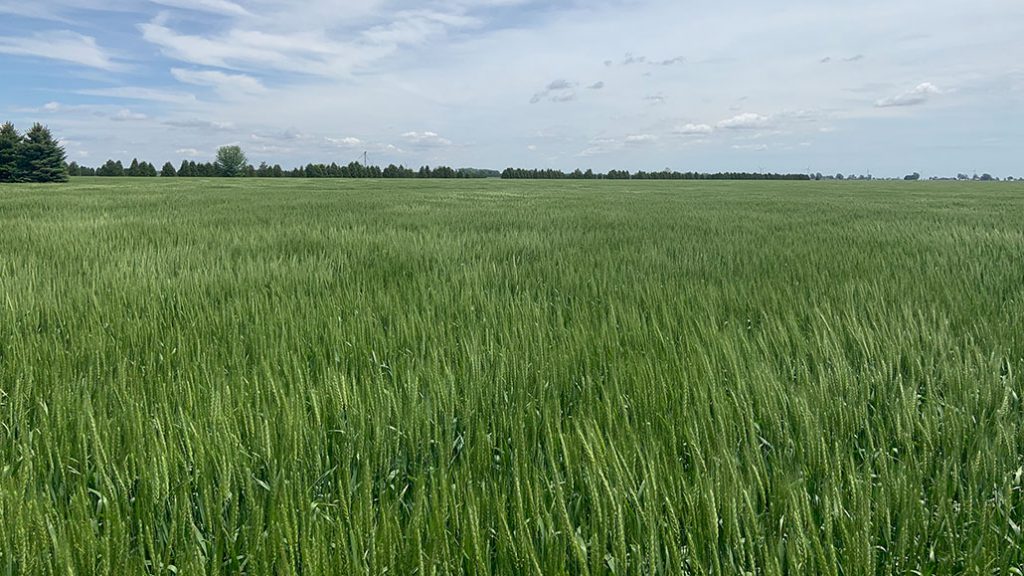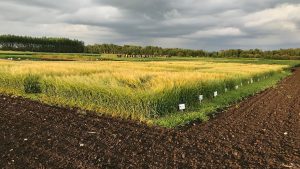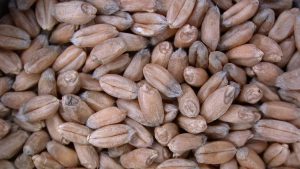Strong expectations
2020 WHEAT CROP

A HEALTHY CROP and favourable markets have created strong expectations for the 2020 winter wheat crop. More than a million acres were planted last fall, and if the weather holds, farmers will be harvesting nearly all of those acres this summer. Only a seven per cent yield loss was reported over the winter.
Winter wheat fields were planted early last fall, with optimal growing days available before winter set in. Spring was slow to start, and cooler temperatures at the beginning of the season did have an impact on the crop, but most issues were managed well.
“We weren’t seeing a lot of mineralization happening in the soils because the soils weren’t warming up. As a result, nitrogen and sulphur deficiencies have been a little more prominent this year. We aren’t getting those released from the soil,” says Joanna Follings, cereals specialist with the Ontario Ministry of Agriculture, Food and Rural Affairs.
Insects were also a concern for several farmers. There were reports of high aphid populations in several counties in southwestern Ontario; army worms were a concern in many regions requiring control; and cereal leaf beetle had to be managed on some fields as well.
However, Follings notes that there was relatively low disease pressure in most fields due to the cooler conditions. And overall, the wheat crop was healthy as we headed into July.
“For the most part, stands are quite good, we’ve got good population, nice even stands, and so I think the yield potential is good for a lot of fields and now it’s just trying to protect that right through to harvest,” she says.
CONTRAST
This year’s growing conditions are a dramatic contrast to what farmers experienced with the 2019 crop.
“When you reflect back to 2019, I would say the majority of growers are much happier with their crops this year compared to last year, we have much better stands and much better yield potential than we did last year given the situation and the stress the crop was under,” says Follings.
Winter wheat was seeded into less than ideal conditions in fall 2018 as wet weather delayed soybean harvest. Some wheat fields weren’t planted until well into October, and that gave little time for the crop to establish itself — some of the crop didn’t emerge until spring. Multiple freeze-thaw cycles over the winter created a thick ice cover that killed off the wheat in many fields right across the province.
And then, as Follings recounts, the prolonged cool and wet conditions in March and April made the situation even worse, “some stands that were struggling just couldn’t overcome the harsh conditions.”
It was one of the worst seasons on record, with 35 per cent crop loss.
MARKETING
“I received a lot of calls from farmers during the spring and summer of 2019 to buy out contracts or roll them to 2020. I don’t think I have ever rolled as many contracts, as a percentage of total contracts,” says Todd Austin, manager of marketing for Grain Farmers of Ontario.
“Every year there is a bit of winter kill, that’s the nature of the business. If farmers have a contract with us, we prefer they call us once they know they don’t have a crop, and we work on a case by case basis with them to find a marketing solution,” he adds.
The wheat that did make it to market was good quality, and strong harvest prices carried through most of the year. Austin notes that over the past few years, the feed trade is buying wheat for their feed rations and that helps to move a lot of grain through the year.
Many farmers had their wheat contracts booked early this year, and Austin recommends farmers review those contracts as we head into harvest.
“You should be very familiar with the quality specs and the terms of the contract. You don’t want to be surprised at delivery if you weren’t aware of what’s in the contract.”
Some farmers who grow soft white wheat will harvest the crop when it is a little wet and then air dry the wheat down to ensure the quality. According to Austin, “it’s certainly better to pay a little for drying than end up with a feed or sample grade wheat. It’s true for all wheat, pay a little bit more for drying rather than risk being downgraded.”
However, Austin cautions that farmers need to do the math, and make sure they take into consideration the added cost of the carbon tax on their drying charges. Follings agrees, noting that if the costs will offset any potential losses, it’s worth taking the extra step.
“Farmers have worked so hard all year to get through to harvest, you don’t want to lose out at the very end. Staying on top of quality right through the end is really important for cereals, and winter wheat specifically,” says Follings.
HARVEST CHECKLIST
Equipment:
- Clean-out combine
- Clean wagons of treated seed
- Clean and inspect trucks for contamination
Safety:
- Ensure all safety equipment is available and in good condition (ie. fire extinguishers)
- Ensure all workers have proper training for the job (www.wsps.ca)
- Ensure vehicles are road-ready and drivers know all vehicle requirements (www.mto.gov.on.ca)
Marketing:
• Carefully read and understand all existing and new contracts
• Negotiate drying and handling charges prior to delivery
• Know max moisture accepted at elevator prior to delivery
• Know your discount schedule
• Know what you have to sell — take a representative sample in prior to delivery
• Ensure you are paid within 10 days of sale, or according to GFPP payment timelines (www.agricorp.com)
• For grade disputes, contact CGC (www.grainscanada.gc.ca)
Insurance:
- Know insurance deadlines (www.agricorp.com)
- Report wildlife damage (www.agricorp.com)










